By C.J. Sturtevant
Photos by Audray Luck
Originally published in USHPA Pilot, July/August 2018
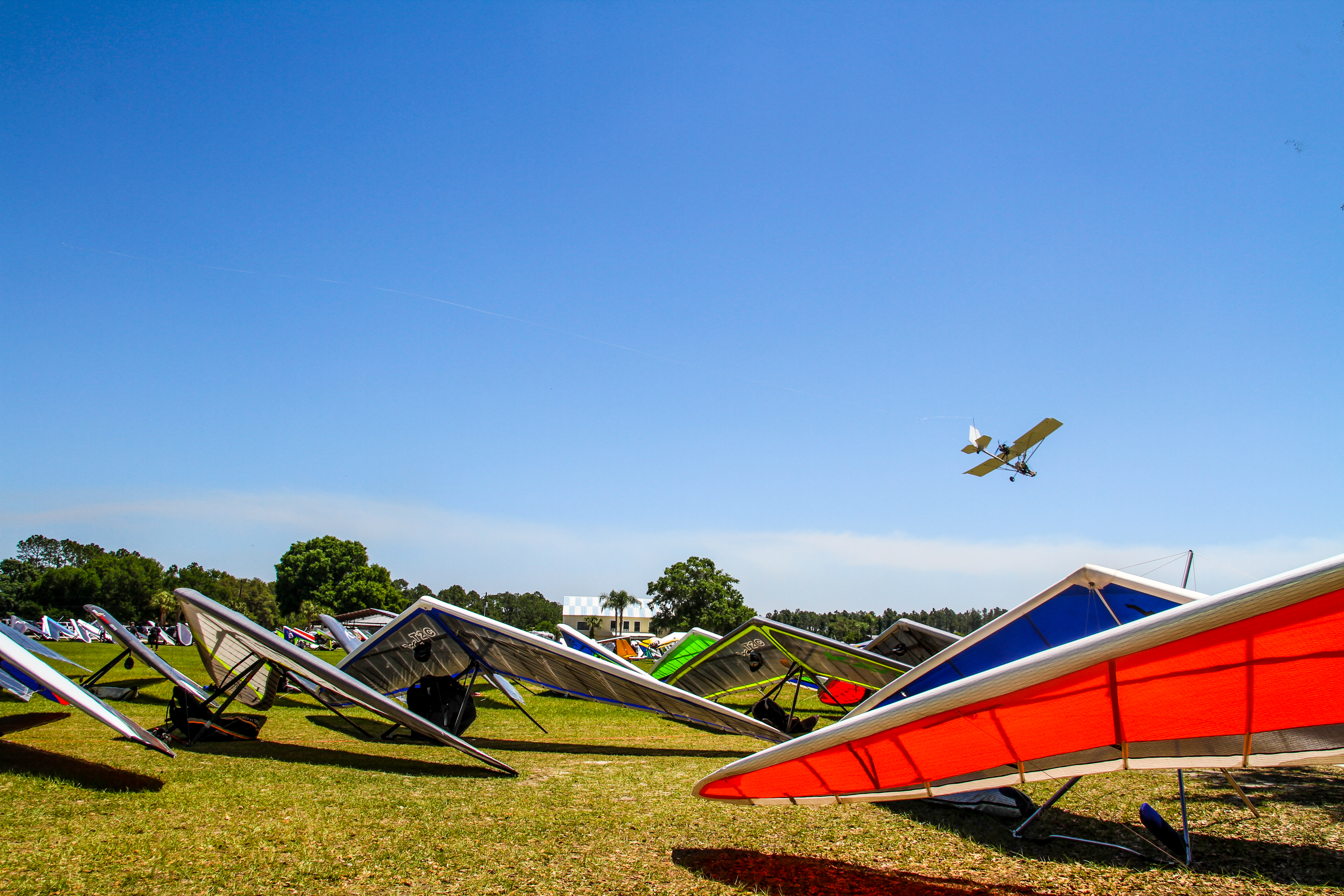
Those who don’t compete on their hang glider or paraglider (and that would be most of you reading this) often imagine the comp scene as a long week of high stress, fierce rivalry, scary launch/flight/landing scenarios, exhaustion--in other words, lots of money spent on not so much fun. Why, you might wonder, would anyone want to do that?
Well, those of you who DO compete can vouch that it just ain’t like that (at least not so much, not anymore)! You can make it stressful if that’s your thing, but you’d have had to work hard (or have flown with your brain turned off) to have put yourself into the high-adrenaline danger zone at the 2018 Quest Air Hang Gliding nationals. I haven’t been to a hang gliding comp, as competitor or crew, in decades, so when editor Nick asked me to write about last April’s comp at Quest Air, I reached out to several of those who were there to get their impression of the week’s events. Their responses almost made me want to drag these old bones and my mini-Falcon back into hang gliding competition!
Just over 100 pilots (52 US, 51 from the rest of the world) joined the fun last April, along with probably as many or more meet organizers, tug pilots, volunteers, spectators, photographers… Ten pilots responded to my requests for their input. Their hang gliding experience ranges from only a few years since first taking lessons, to decades since that first flight, some with a break to raise kids or deal with work/school/health-related responsibilities, some who’ve made competition flying a major focus of every hang gliding season. For some it was their first comp; for others, they’ve lost count.
What drew 103 pilots to Quest Air to compete in the 2018 US Nationals last April? Their motivations might surprise you. Here’s what a few of those 103 had to say:
John Simon, a 14-year hang gliding veteran with a couple dozen comps over those years, started out in Sport class a couple years back and now flies his Aeros Combat in the Open class. He likes Florida’s weather and flying conditions, and the “LZs make it a safe and stress-free place to fly XC. I like tow comps and low winds that allow for at least some of the tasks to be return style or short retrieve.”
Charles Cozean entered his first competition at Sandia, New Mexico, back in the early '90s. His second comp was last summer, at the Midwest 2017 in Whitewater, Wisconsin. “Man, what a change from my first comp, where we had maps on our bar mitts and a camera to prove we’d hit the waypoint and just a radio for retrieve! The technology we have now--the flight instruments, messaging, weather forecasting--really make XC more approachable and fun.” He points out that the comps bring local site and weather and flying experts together to engineer the day’s best XC task, “and then you get to fly that task with a bunch of really good pilots and a dedicated retrieve. How else are you going to get that? For me, Quest was an opportunity to see the old gang again and dip my toe back into XC.”
Gary Anderson learned to fly the first time back in the ‘80s, but dropped out for a couple decades, until some workrelated passes through the John Wayne airport in Orange County, California, re-ignited his passion. “Wills Wing had a display, including a Sport2 and a T2, hanging from the ceiling above the baggage carousel, right at eye level about 25 yards from the security checkout line on the second floor,” Gary recalls. “Those two gliders really got under my skin.” After refreshing his skills with Rob McKenzie of High Adventure, he acquired his own Sport 2 and entered his first comp in the Sport class in the 2016 Santa Cruz Flats Race. The next year he moved up to a T2C and now flies in the Open class. “I attend these events to fly farther and faster, and to really see and understand what is actually possible. I certainly get those two things each time I go to a competition!” Gary enthuses, and adds that the Florida flying was “probably the most stress-free XC I’ve ever done, AND I got to fly and hang out with some of the best hang gliding pilots in the world. The lessons learned are real and will stick with me.”
Glen Volk has been flying since 1978 and competing for 35 years. “I love racing. I love goals, and I love Florida flying,” he says. “I am so happy that comps are back at Quest!” He also really appreciates some of the advances in technology: “The Fly Trackers we used were insane--they are something we should always use. No more downloads from the flight computers!”
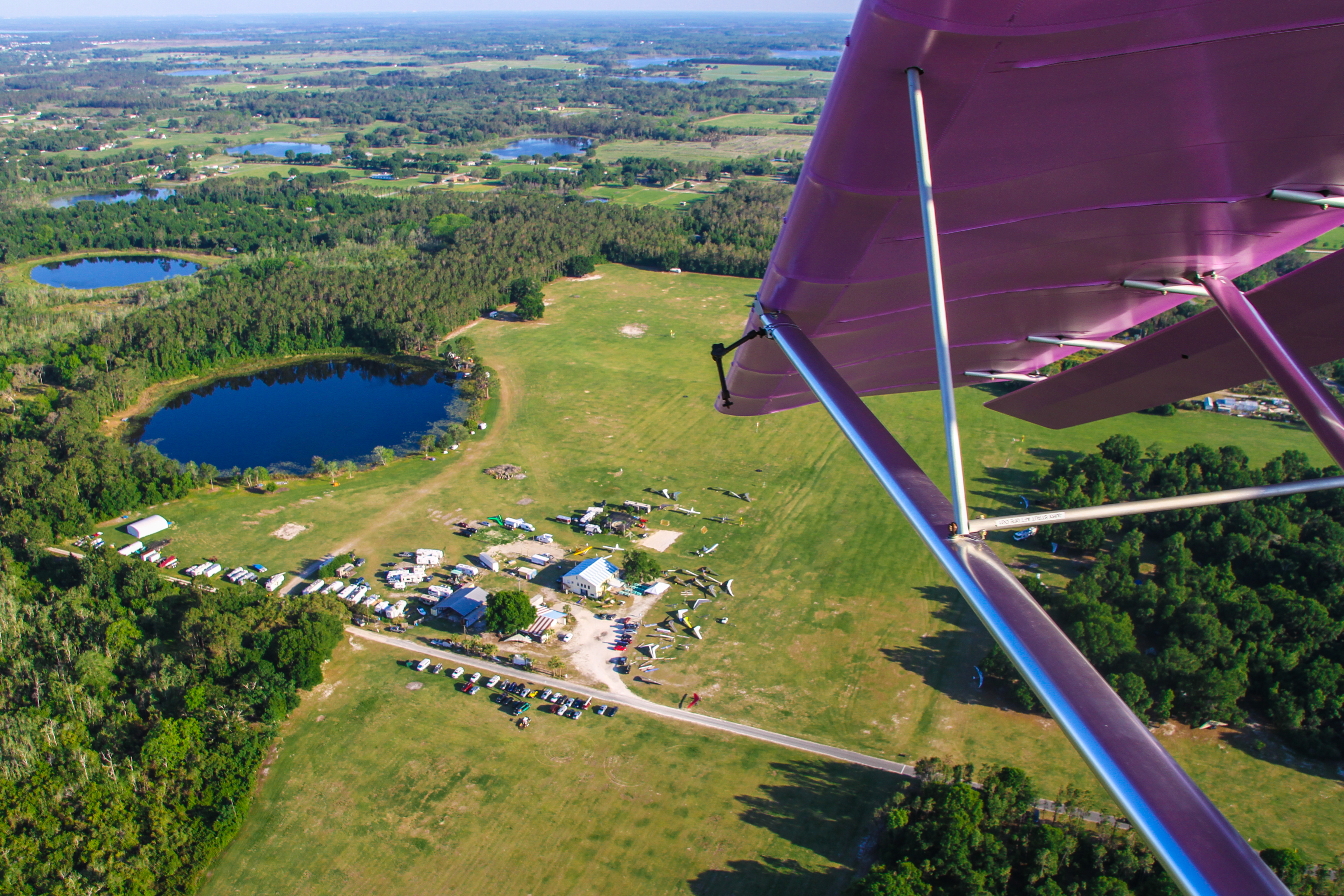
Kris Grzyb started hang gliding more than 30 years ago, and has been competing for around 20 of those years. He lives in Chicago and is instrumental in making the Midwest comps happen, so he brings perspective both as a pilot and an organizer. He totally enjoys competition flying, he says, “when I have time and money,” and elaborates: “I love to fly with all my domestic and international friends, and I also love making new friends.” And then there’s the weather factor luring him to Quest: “The flying season opens in April in Florida, but it’ll be a month or more before we’re flying in Chicago.”
Sara Weaver has been hang gliding for just five years, and flew her first comp (the Green Swamp Sport Klassic, at Quest) in 2017. She’s set a personal goal of “competing in every sanctioned Sport-class competition in the US this year.” She flies a WW Sport 3, loves flatland thermal flying and aerotow, and “I absolutely love the competition community! I always feel like my brain is about to pop by the end of the week because I’ve learned so much and made so many new friends!”
Stephan Mentler started competing in Sport-class events in 2011, and moved up to the Open class in 2016. Family responsibilities grounded him for about 15 months, but he’s back now, flying a kingposted Icaro MastR in the Open class. Florida, he says, “is a great stress-free place to compete. There is an abundance of large and safe landing fields, which allows a pilot to focus on the sky, and while you always need to retain situational awareness of the terrain, you’d have to work hard to put yourself in an unsafe situation (i.e. low and over an unlandable area).”
Richard Milla has been flying since ’93, currently on a U2, but he just bought a T2C. He competed in last year’s Green Swamp Klassic, and found he really enjoys the “set-up and ease of flying” in Florida.
Davis Straub, along with his wife Belinda, organizes and runs many of today’s US hang gliding comps. Davis has been flying since the early ‘80s and has accumulated more than 5,000 hours and over 100 comps around the world since then. Currently he flies a WW T2C 144. He came to Quest because, well, “we’re running the thing!”
Zac Majors started flying in ‘92, competing in the mid-late ‘90s, but didn’t get serious about competition until 2007. He currently flies a Wills Wing T2C 144, and he came to Quest to win. He was successful!
While miles flown and standings and who beat whom are hot topics of discussion during any XC comp, those statistics were typically not the strongest memories pilots brought home from Quest. When I asked pilots about their “most memorable” flights, their criteria for “memorable” varied widely. Gary, for instance, uses “lesson learned” as his defining focus: “I was pretty happy with my ‘middle-of-thepack’ results at the pilot briefing on the last day. The final task had really good weather and clouds, and at 127 km (79 miles) it was the longest task of the week. Because of how the launch order is determined, I launched in the middle of the pack and right behind Christian Ciech. I unpinned and quickly made it to cloudbase with Christian and about 50 of my closest hang gliding buddies. The cloud suck was strong--not scary, but strong enough that we were all flying pretty fast and sometimes skirting up the sides of the clouds to stay out of them.
“About 10 minutes before the first start window I noticed that I had drifted to a different set of clouds from the gaggle so I decided I needed to rejoin them before they all took off. So I pulled my VG tight and set a course directly for the gaggle. There was a blue hole between us, but it was not that big. I was fine for the first few minutes of that glide, but towards the center of the blue the sink increased. I changed my line to the left, then to the left again and again but no luck; the sink continued. By the time I reached the clouds on the other side I was around 1200’ msl. No problem--there was a little texture in the air and I was confident that I could find my way back to the clouds. I fly in the Western mountains and high desert where the air has lots of texture and the thermals, especially down low, are very pronounced. You might not be able to core them, but you can’t miss them.
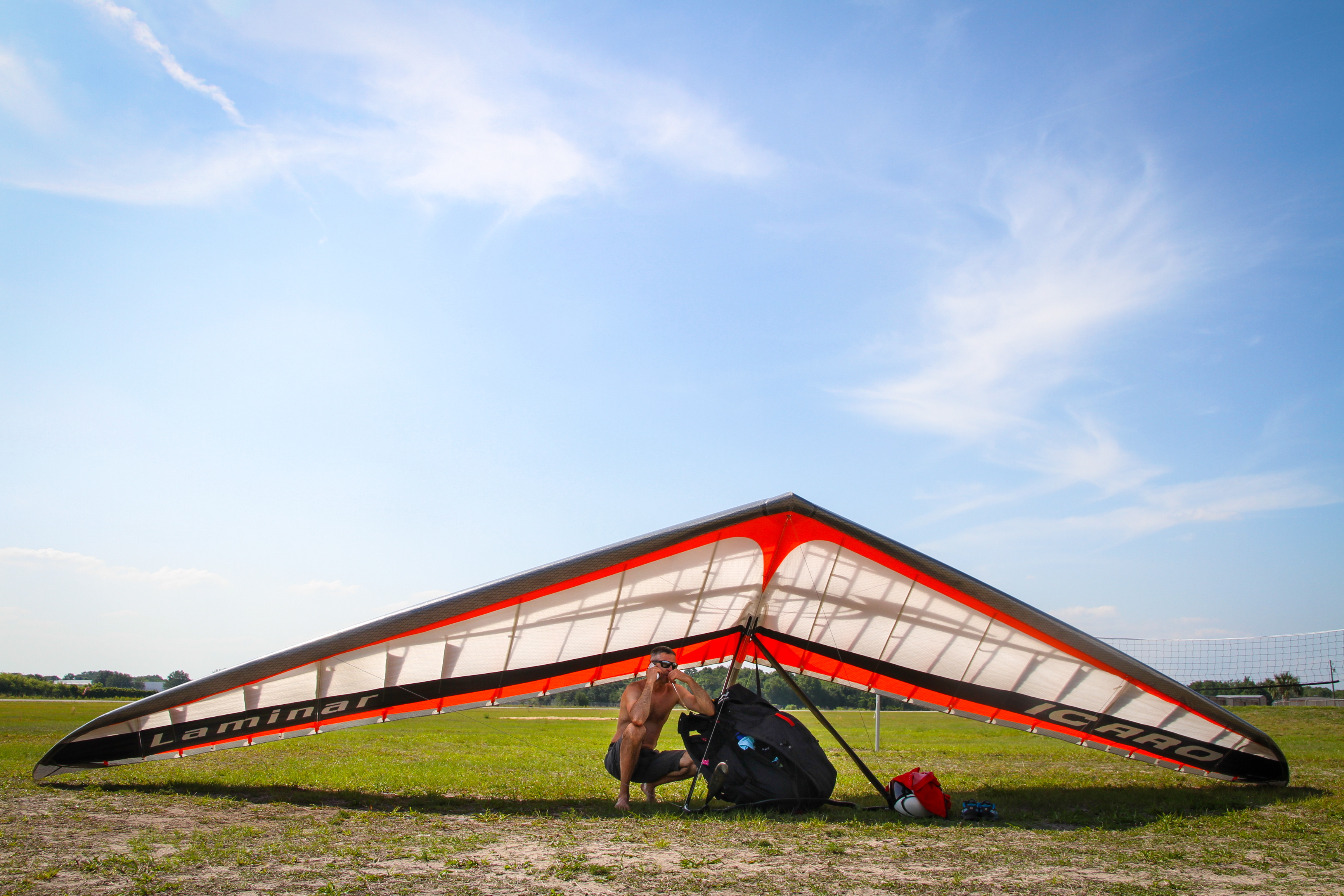
“On this day, Florida was not like that. I worked weak lift for 10 or 15 minutes, going up and down between about 1200’ and 2500’, before I was joined by three other pilots. They worked the same area for about five minutes then went on glide back to Quest for a restart. I should have done the same, but ‘restart’ was not in my vocabulary. Landing is losing--at least that’s the way I used to think. Ten minutes later I was on the ground a few miles from Quest. You cannot restart unless you land back at the airpark. I was done. I sat on the side of the road for a few minutes and just stared at the clouds. It was bad enough that my score would tumble but those clouds really hurt. It was as if I were playing golf on a beautiful spring day and got a bogie so someone took away my clubs and made me watch. Uggh!” Gary lists a few of the lessons he learned from that flight: “Don’t fly alone, stick with the gaggle; blue holes are bigger than they look; landing and relighting is NOT losing…”
Glen wasn’t sure if I was asking about the most memorable flight of the comp, or of his entire flying career. “If you mean the comp,” he says, “I liked the first day because it looked like a marginal day. The air was like butter and it was a super-fun short flight. (Although honestly, all of my flights at this meet were super fun.) The last day’s task was the longest, and I liked having to come back a ways from the last turnpoint. I love flying through the Lakeland area--it amazes me to see how good the lift is there, with so much water. I watched two guys thermal across a really big lake. I thought they were high and climbing but then as soon as they were on the other side they turned and landed. Whoa! I guess my perspective was a bit off! Their sphincters must have been pretty tight in the middle of that lake because they could not have been that high.”
John, like Gary, recounts memories of making mistakes or overcoming adversities. On the first task day, which he describes as “super low and weak and blue,” the task committee called a short zigzag to Wallaby for the Open class. “I don’t think I got above 3000’ until the last climb--my first three climbs topped out at 2200’, 2500’ and 2300’ feet. Gliding to the next blue thermal at that altitude was close-contact flying and really got my attention. I was below 2000’ for much of the ride, in the blue and often alone. Wow, intense and rewarding!” Then there was the last day, which, he says, “I totally messed up. I blew the start, letting Nene blast out in front, then I got low and took the late 3rd clock all alone (or so I thought) and flew alone until I was joined by a few others 30 or 40 minutes later. Being in front (of this clock--i.e. I could not see others ahead), I pressed on and continued to err, flying initially in nice clouds but then blundering into a blue hole half-way to goal and barely staying up. Going far to the east, I separated from all other (smarter) pilots, as they went west. I flew alone and crossed another large blue hole to finally arrive at the last turnpoint, where I found OTHER PILOTS, plus clouds!! Wow, so happy! I finally tapped the TP and went to goal, getting in very slow and very happy.”
Kris is clearly a man of few words--or perhaps his brain is too chock-full of memories to pick out one as “most” noteworthy. “Each flight is memorable!” he says, but then elaborates slightly: The first task sticks in his mind because he “bombed out when conditions were very weak (max altitude 2500’)” but the rest of the week went well for him. “All remaining tasks were good memories! I made the goal with good time.”
Zac’s favorite task was the last one. “I had won the previous day, by enough to put me into 1st overall just ahead of Christian, which meant I just had to fly solid and not screw up. At the first clock I was in reasonable position to start, but I knew the day was still getting better and I couldn’t find Christian, so I decided to wait. When the second clock came around I was groveling low, so clearly I couldn’t start, right? Well, 20 minutes later at the third clock, I was only slightly higher, so those first two clocks were looking a lot better in hind sight. Kevin Carter and I finally pushed out, and had lots of pilots in front of us. The day was a nearconstant game of hop-scotch with the pilots and clouds in front of me. I had given up all the lead points, so speed would have to suffice to save the day and my comp. Racing into goal with several flex-wings and right behind the rigid wings, I didn’t see anyone there... until I walked far enough to find Christian breaking down alone, behind the building. He had taken that first clock farther east, where I couldn’t see him, and charged the course alone like a champion. He had won the last day, but I could still hope it was close…”
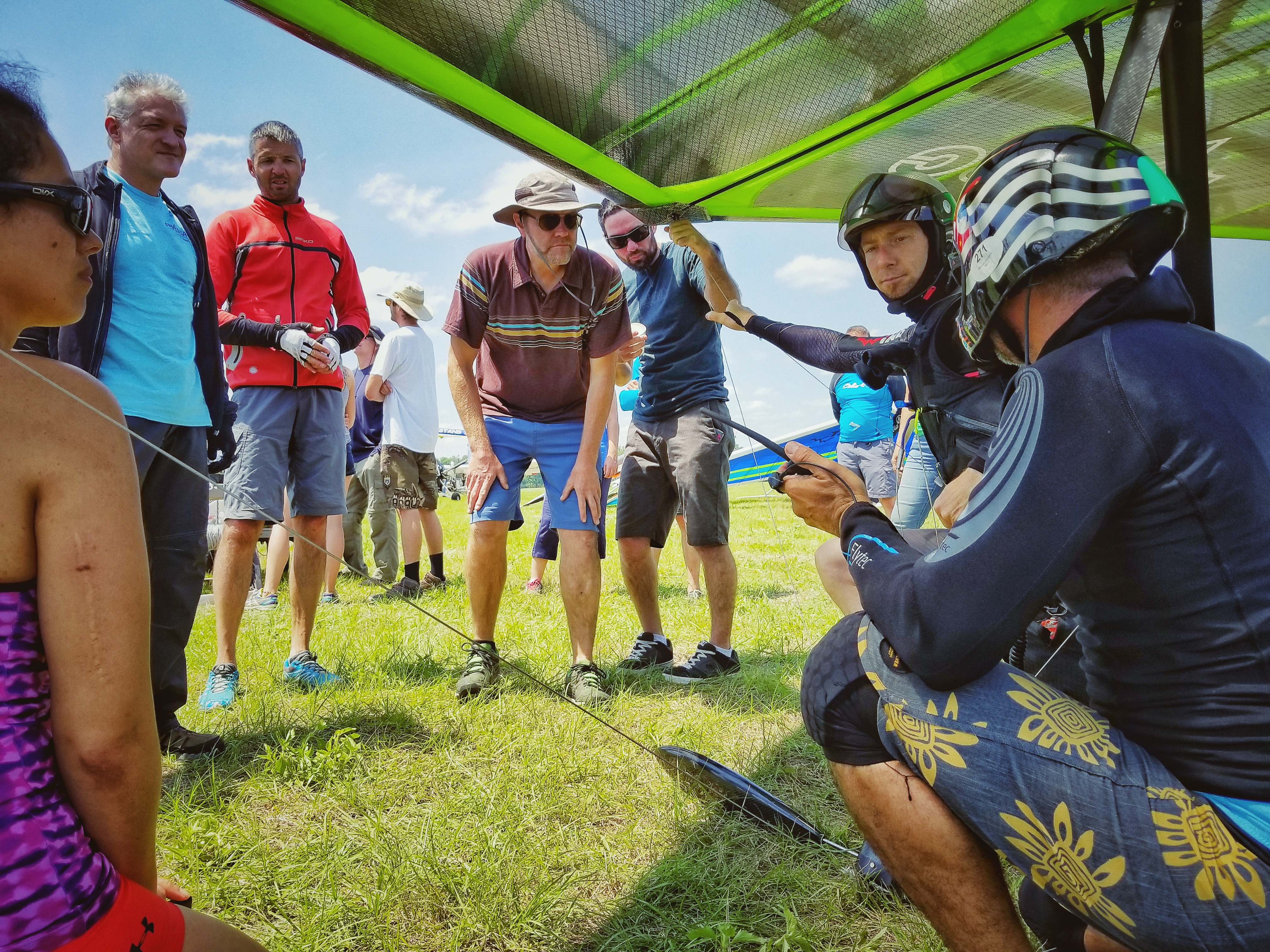
Davis cites the “cross-wind task to Chalet Suzanne, flying upwind against a strong wind perpendicular to the course and climbing while gliding” as most memorable. He didn’t mention whether he made goal, so apparently to him it was the journey, not the destination that was of interest this time.
Richard’s most memorable--and most challenging--flight came on the practice day, before the comp even started. “I got low about nine km from Quest but got back up enough to get back to Quest. That’s the only out-and-return I’ve ever done!”
Sara really enjoyed what she calls the “tomahawk task” on day 2. “The Sport class had three waypoints, and returning to Quest was goal. Any day where a triangle (or similar task, like this one) is involved, I am so happy. These tasks are HARD! You’re pitted against the wind in a different way after each turnpoint, and the mental power it takes to stay up long enough is exhausting. I love the challenge! Also, the Sport class task overlapped with the task for Open, so we were flying together most of the time I was up. The gaggles were the biggest I’d ever been in, and it was so fun darting around and moving with the other pilots.” Zac also found that task interesting, “because we flew over Quest on the third leg, which I think people enjoyed watching, and then we raced back to finish in front of them.”
Stephan cites the task on the last (flyable) day as his most memorable: “It was good, then bad, and then good again. The good: a low save (around 400’ AGL) over Seminole Glider Port, thanks to some vultures that showed me the lift. I climbed to cloudbase--albeit it took me a while. The bad: It was a windy day and I did the rookie mistake of landing too close to the leeward side of trees, got caught in rotor and power whacked. The good: It was Wallaby Ranch and I got to say hello to Mike B., was offered beer by Malcom, and met some new pilots, including a couple from the northeast who had run over to make sure that I was OK after my, well, can’t really call it a landing…”
Clearly, not all fond memories from a comp are related to the scores and standings!
I asked these pilots what they’re taking away from their week of competing at Quest. Gary (of the “uggh!” memory) says, “Objectively, the 2018 Quest Air Nationals was a big success for me. I did probably the most stress-free XC I’ve ever done, AND I got to fly and hang out with some of the best hang gliding pilots in the world. The lessons learned are real and will stick with me. Subjectively, I still see that gaggle on the other side of the blue hole, I still see those three other pilots heading back to Quest and I still see myself sulking on the side of the road staring up at those clouds. I am signed up for the 2018 Big Springs and Santa Cruz Flats Race where I will apply a few of those lessons.”
Glen says, somewhat ruefully, that even with his decades of comp experience, “I am always re-learning to hang in there. I had a 400-foot (or so) save…”
Sara, who flew in her first comp last summer and whose “brain is about to pop by the end of the week,” provides some details of the brain-popping experiences. “I learned some really valuable technical skills during this competition, including how to adjust the tension on the leading-edge and tip-wand levers on my Sport 3. Before the competition, Jonny Durand casually asked me how my pages were set up in my 6030. That question led into an impromptu two-hour clinic to hone my vario-reading skills. I also participated in Mitch Shipley’s landing clinic using his Elektra Tow system. I learned so much about the technical aspects of landing and as a group, we evaluated nine of my landings. That clinic played a pivotal role in helping resolve my landing anxiety.”
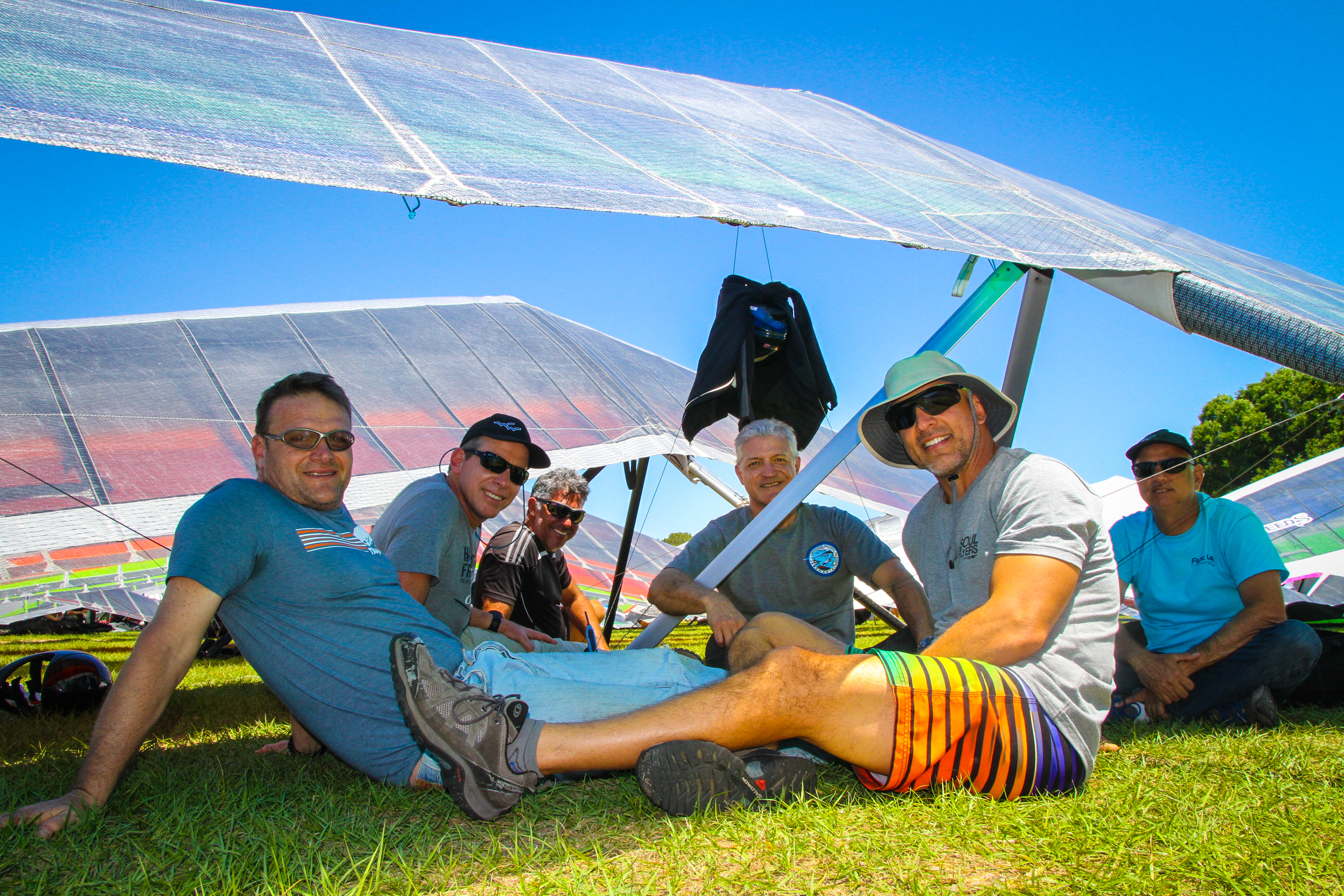
Besides developing her technical and landing skills, Sara has been “intently focused on improving my mental endurance during these long competitions. Usually, I find myself riding an emotional wave of great successes and terrible losses and it really wears me down by the end of the week. During this comp, I asked so many pilots how they cope with the ups and downs. It seems like the pilots with the most level heads typically do well, and I latched onto that with my whole being. I had one single goal all week: Be happy. From what I can tell, it worked this time! I had no crazy rollercoaster moments, and I believe my performance reflected that.”
Richard strengthened his awareness that “keeping an eye on what other pilots (and birds) are up to, with everyone spreading out to map the sky, can lead you to better lift, a better line on glide. There are big benefits of flying with other people… Patience and perseverance are key, sometimes offering the reward of finding a massive climb!”
Even though I didn’t contact Charles until several weeks after the comp had ended, he still finds his experience at Quest truly amazing. “Being able to fly with some of the best pilots in the world is awesome! I pay a bit of money, show up and now I can learn from and fly with these guys? Ridiculous!”
John goes to comps “for the people (and the beer). Really, the flying in Florida is great and consistent and soft and smooth and safe, but when all is said and done, without all the great people it would lose its appeal over time. Flying and BSing with all the pilots and drivers and tug pilots and volunteers every day is what makes it great. Each year you meet new people and that alone is so enriching it’s worth it. Plus, there are reunions with folks you’ve not seen in years. We all love to fly, but even though many probably don’t consciously acknowledge it… it’s the people that make it.” Zac also cites “our community” as a major appeal of the comp scene, and adds, “so opportunities to hang out in the evening are great; the karaoke night was a fun chance to get silly and have a laugh together.”
Because USHPA is strongly focused on improving safety in all aspects of free flight, I asked these competitors for their take on the safety features of the Quest Air nats. With no exceptions, all were favorably impressed. “The safety issue was raised every day during pilot meetings,” says Kris. John gets more specific: “The last day was marginal; many thought it could have been a fly day and at many sites it would have been. At Quest, west winds are more restrictive than the other directions… 20 is OK from the north or south, but west winds can be nasty at 15 or less. We didn’t fly, even though the sky looked good, but T-storms came later and the wind was never really great. Most would probably have launched fine, but IMHO not all, and that’s not acceptable. We cancelled and it was a tough but good call. Also, they cancelled the Sport class on a day that was marginal as well, while the Open was allowed to do a task… great call.”
Sara was also impressed with the Safety committee’s call on that last day: “Many Open pilots had launched (several dangerously), and there was a heated debate on launch about whether the Open class should be canceled. Some pilots were pushy to fly; others were angry that launch hadn’t been closed during the gustiest conditions. As I watched all this, I made the decision not to fly that day unless conditions improved. It was the first time I’d ever grounded myself and accepted a 0 score. Twenty minutes later they canceled the Sport class anyway, so I felt even more confident that my decision had been the right one.”
Charles appreciated the conservative decisions of the Sport-class Safety committee. “They canceled several days even when we could have flown, I think. But most of us weren’t keen to fly the conditions anyway.” He recalls a time back in his early hang gliding days when some of the tow parks required pilots to have wheels or skids on their gliders, and feels it would be a significant safety enhancer. “I never flew with wheels until I had to, and then I grumbled about it. But now I won’t tow without them. I’d love to see an estimate of what glide penalty we pay for the streamlined wheels--I’d guess it’s quite small, and knowing that might encourage more pilots to fly with wheels--at least in the Sport class.”
Stephan was also impressed with how safety always seemed to be a major driving factor in the day’s flight plans. “The Task committee called challenging (e.g. upwind, crossing, etc.) but safe (always proximate to safe landing areas) tasks. We had a great Safety committee who judged the conditions well and had no problem calling the day if it appeared that it would be unsafe. Our weather person, Larry Bunner, provided each day’s forecast (e.g. wind speed, direction, chance of precipitation, and T-storm)--micro-meteorology and meteorology are big safety items that I think are often overlooked by pilots. The general attitude of the organizers, pilots, crew--everyone!--was, this comp is for fun! Pilots were free to make the choice NOT to fly, no questions asked. You don’t always see this in non-comp environments. And Davis provided a pilot briefing document ahead of the competition that included general orientation to the site, safety procedures, and even imagery.”
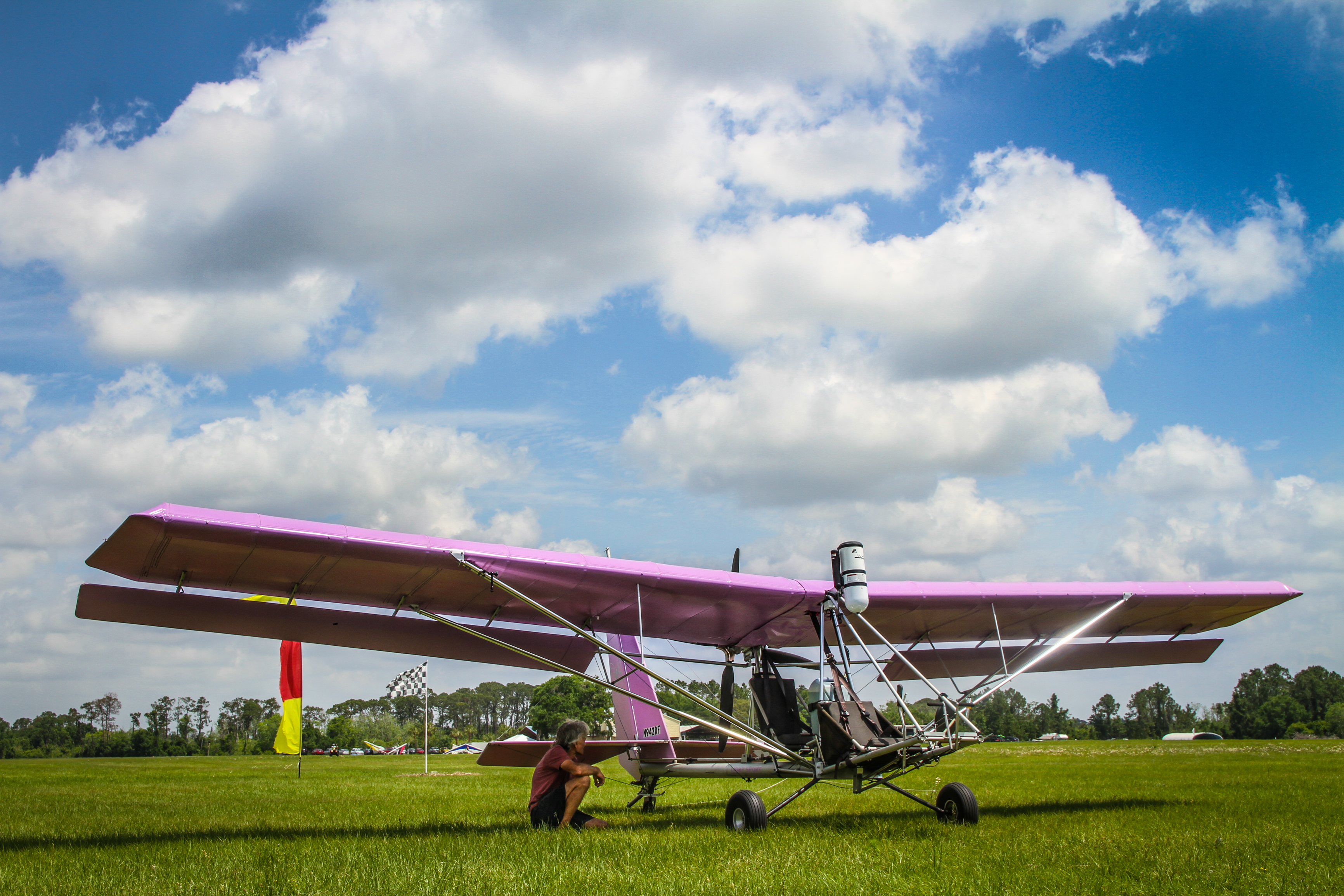
Glen probably has the widest experience with safety in comps over the years, and is quite impressed with the focus on safety in recent comps. “I don’t think we can ever eliminate accidents completely,” he says, “but I’ve been competing for 35 years and it’s never been better than it is now.”
So, there were a few days during the comp when flying activities were canceled. Fortunately, there are plenty of other options beyond chucking rocks at alligators, and many pilots put their “down time” to good use. John says he and a dozen others went “mountain biking” on one day (Really? Mountains in Florida?), and took another of the no-fly days as family time, as did Richard (who suggests a trip to the Cornerstone Grill in Lake Alfred would be totally worth your time). Kris (who’s from Chicago) took advantage of the opportunity to visit the nearby NASA sites, and highly recommends other “foreigners” do so if they get the chance. Zac drove to try to see the SpaceX launch, which “ended up being scrubbed because… it was too windy.”
For Sara, at least one of the no-fly days was as brain-popping as the task days. She describes a trail run with several of the top-ranked pilots in the world: “Most of our conversation revolved around competition mindset. We talked about how to stay cool and roll with the punches, about both mental and physical endurance and what it means to be an athlete in this sport. We discussed why there are so few women in hang gliding and whether or not that could change over time. I got a small peek into the brains of some of the best hang glider pilots in the world, while I was doing one of my favorite things--running! It was,” she says, “one of my favorite experiences of the whole week.”
Stephan describes himself as “a dessert guy”; luckily for him and other like-minded pilots, Clermont offers some excellent options for satisfying the ice-cream hungries. “It was Brusters Real Ice Cream one day,” he recalls, “and Ritters Frozen Custard on another where, I believe, Jonny D tasted his first-ever frozen custard.”
Davis (who’s in charge of these details) says, “When there is a competition at Wilotree Park (Sheet Airfield, Quest Air Soaring Center), it is accompanied by parties, lots and lots of parties. Because we have a central site for everyone to rally around, people hang out at the ‘Out of Control Bar’ and soon the party happens. Add to this, John Simon hires a club entertainer/DJ/karaoke, and it is amazing that anyone can fly the next day. Thankfully the most out-of-control party happened after the awards ceremony.”
Finally, I offered these pilots an opportunity to give a shout-out to anyone who made their experience at this comp particularly rewarding. Well! I could create an entire article from their enthusiastic responses! Everyone put Davis and Belinda, the tug pilots, and all the volunteers and drivers at the top of their list, but they didn’t stop there.
Davis, from the perspective of both organizer and competitor, elaborates: “We were well prepared to handle all the demand, and the Bailey-Moyes Dragonflies and Gregg Ludwig’s trike got pilots launched very quickly. Because launch was so efficient, getting all pilots in the air in less than an hour, very few pilots chose to go in the ‘early bird’ slot, and many chose to go to the end of the staging line.” He adds Russell Brown and Zhenya (the scorekeeper) and Tony Mercado for handling the trackers, and Belinda for being the meet director.
Glen adds “the guys who bought Quest and made it possible. For sure Spinner--he was launch director and basically runs the airport--really great with helping out in all aspects of the comp. Tony the scoring guy who handled the trackers.”
Charles singles out “Kevin Carter and Zac, at the risk of excluding so many others. They were just over-the-top helpful with flying and glider and instrument tips--even test-flying our gliders and offering tuning advice.”
Gary’s kudos includes his driver, Linda Salamone. “She was part of the volunteer launch crew and she is the one who told me to stop listening to the launch line chatter and go figure out the conditions for myself. Great advice!”
Kris, like Davis, is a meet organizer as well as a competitor, and like Davis he really appreciates the experienced tow pilots. “They always take care of hang glider pilots and their safety. They really know what they are doing! (I know a lot tow pilots, but these were the best!)”
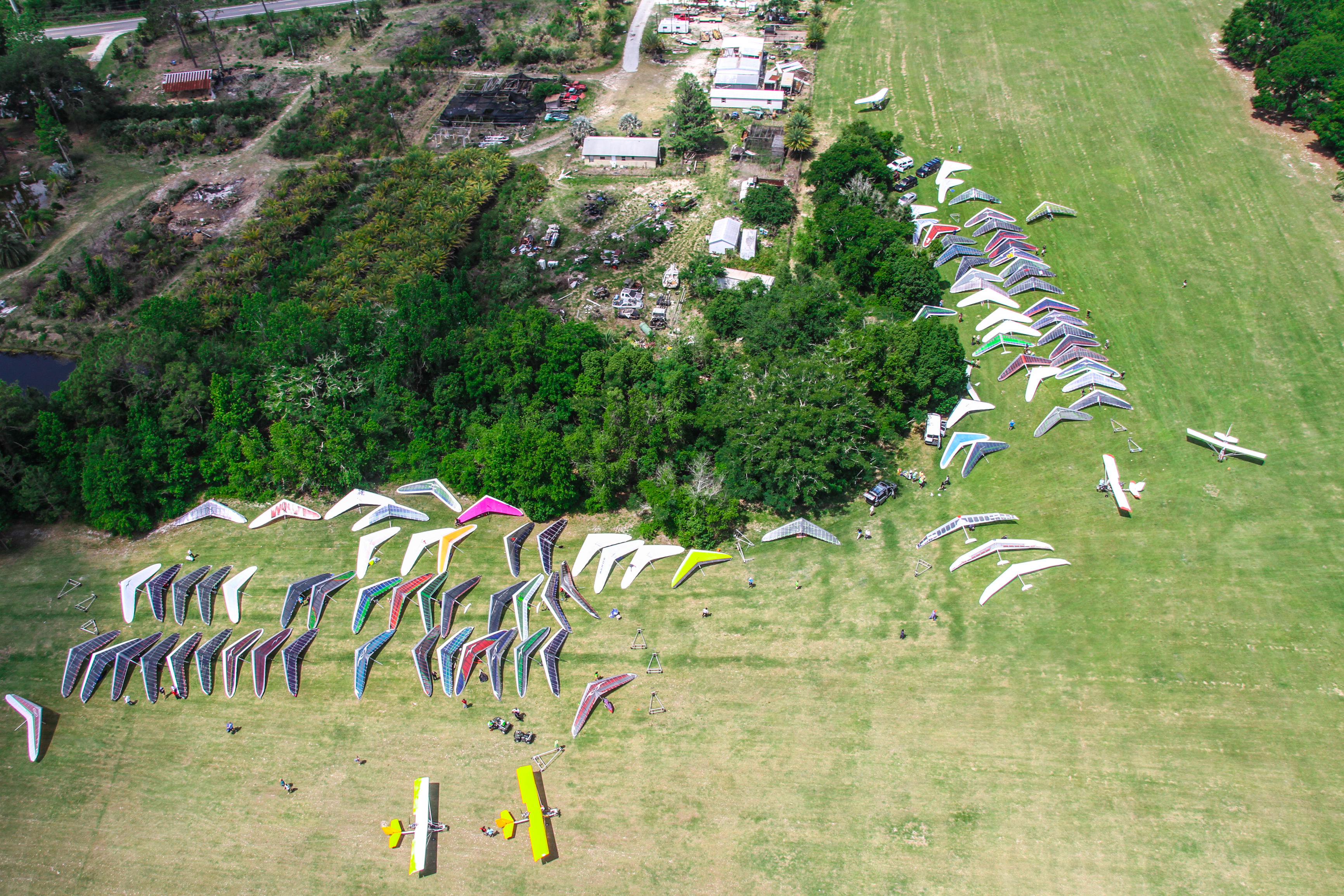
Sara thanks “Jonny and Christian for making my brain a tiny bit bigger, to Kendrick Stallard for your humor and camera talent, to Dave and Steve at Wills Wing for your guidance on the Sport 3, to Philippe and Fabiano for your mad frisbee skills, to John Blank for helping out in a million different ways, to Belinda for low-key being the most talented woman in the hang gliding world, to Davis for everything you do behind the scenes, and especially to Heather Renihan for helping me to stick those GD landings!”
Richard includes in his list “all the world class pilots (especially Zac, Jonny D. and Christian) who were happy to share their experience and knowledge with us aspiring Sport-class pilots, and my wife, Angelyn Zephyr, for her support and retrieve.”
Zac sums it up well: “Our community works hard to make comps like this happen, so the list is long: Belinda and Davis, Quest and the tug pilots, but especially the volunteers and drivers! My wife Majo makes the world go 'round!”
Some closing thoughts: If all this talk of low-stress, high-satisfaction, brain-popping fun has piqued your interest, check out the Calendar pages in the back of every USHPA mag, or the online competition calendar. Local clubs and chapters often hold fly-ins and comps that are perfect for anyone just getting started in XC flying. Don’t wait till the last minute, though, especially for the sanctioned events. Charles reminds us that “the Quest comp (and I think the other US comps), filled VERY quickly--like in a day or two. I’ve heard that it wasn’t so long ago that comps were tough to fill. I’m guessing lots of pilots couldn’t participate this year, which is a shame. For a guy who mostly likes to just fly the tasks vs. the racing aspect, I worry about taking a spot from someone who has the fire to compete--especially the younger pilots. I hope the comp organizers can noodle on expanding comp opportunities."